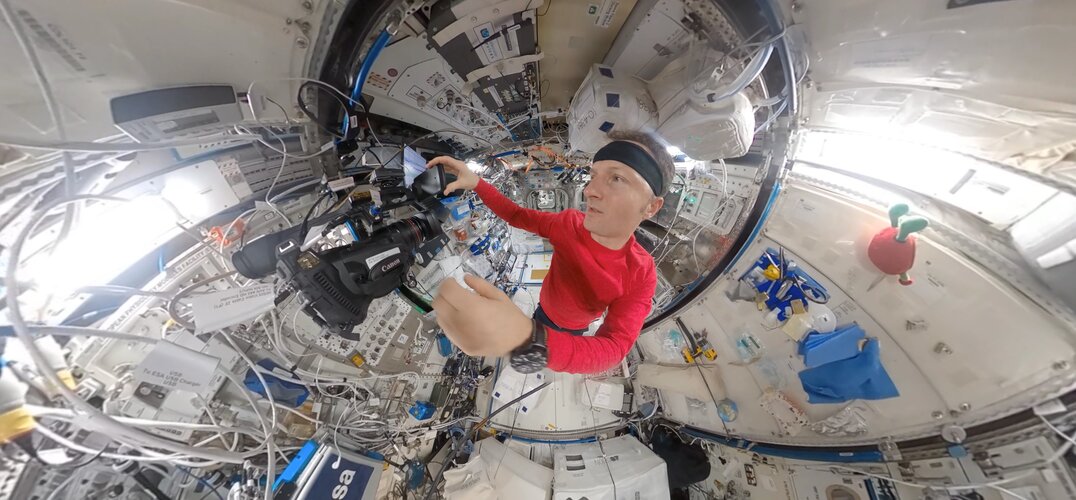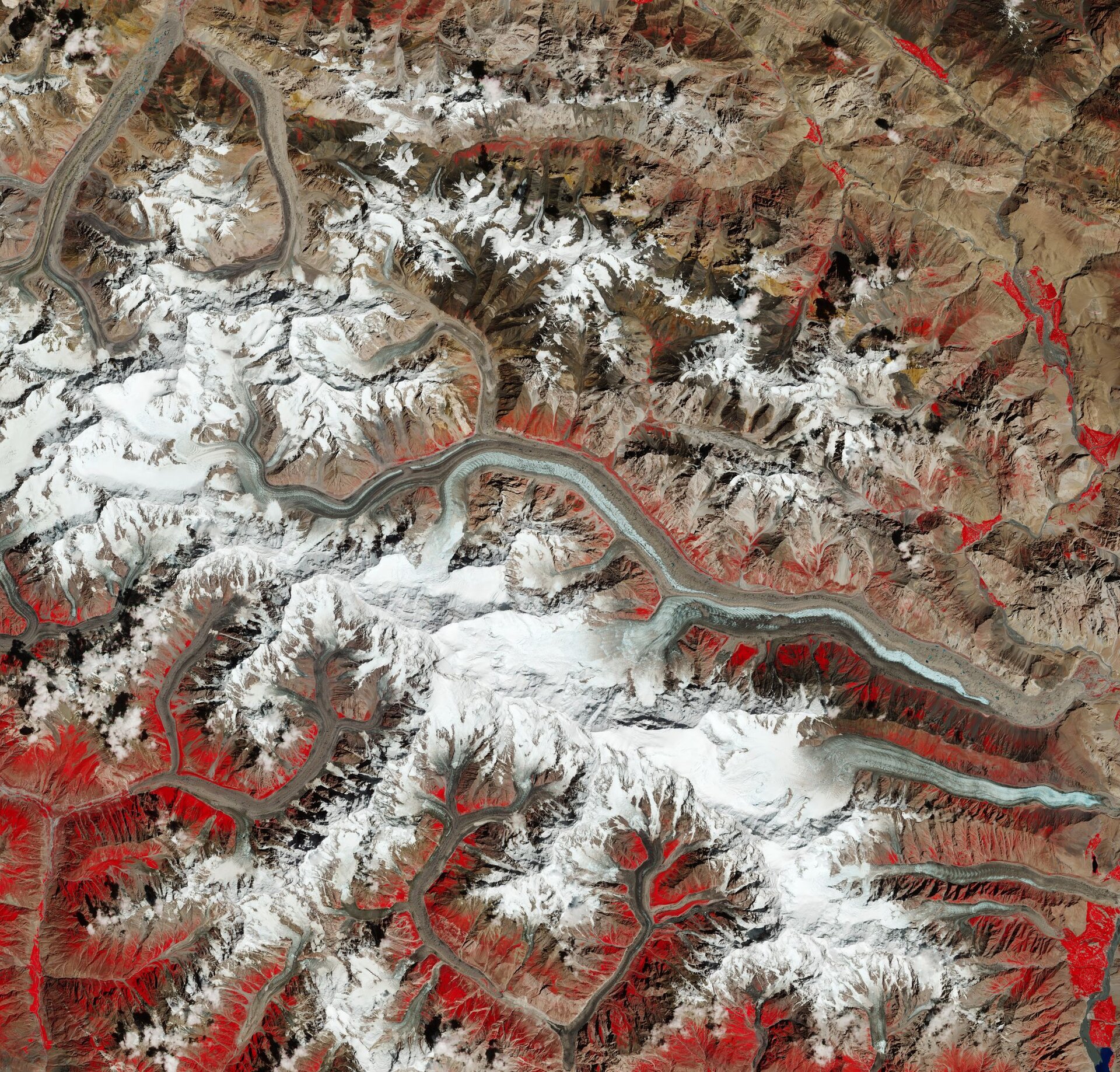
Space repairs in 360° | Cosmic Kiss
https://www.esa.int/ESA_Multimedia/Videos/2022/02/Space_repairs_in_360_Cosmic_Kiss?fbclid=IwAR2jgDuCIzT7g8-PzFM2Hr4NiThiQeeAlelUqiDHy9wFmxQSODAMkmgTB1w
The Copernicus Sentinel-2 mission takes us over Batura Glacier – one of the largest and longest glaciers in the world, outside of the polar regions.
Located in the upper Hunza Valley, in the Gilgit-Baltistan region of Pakistan, the Batura Glacier is visible in the centre of the image and is approximately 57 km long. It flows from west to east and feeds the Hunza River in north Pakistan, then joins the Gilgit and Naltar Rivers before it flows into the Indus River.
The lower portions of the Batura Glacier feature a grey sea of rocks and gravelly moraine (an accumulation of rocks and sediment carried down by the glacier often caused by avalanches). The glacier has a mean ice thickness of around 150 m, with the lower parts of the glacier holding most of its mass.
This false-colour composite image uses the near-infrared channel of the Copernicus Sentinel-2 mission to highlight vegetation, which appears in red. Batura is bordered by several villages and pastures with herds of sheep, goats and cows where roses and juniper trees are quite common. In the upper-right of the image, pockets of cultivated vegetation alongside the Gilgit and Hunza rivers can be spotted.
Batura Glacier is located just north of the Batura Muztagh, a sub-range of the Karakoram mountain range, which includes the massifs of the Batura Sar, the 25th highest mountain on Earth standing at 7795 m, and Passu Sar at 7478 m.
Glacier shrinkage is a prominent sign of ongoing climate change. However, unlike many glaciers around the world, the glaciers residing in the mountain ranges in Karakoram are not responding to global warming. Their retreating is less than the global average, and in some cases, are either stable or growing. This anomalous behaviour of the region’s glaciers has been coined the ‘Karakoram Anomaly’.
Scientists typically measure the motions of glaciers with ground-based measurements. Because of the rugged terrain and challenges involved in field studies, long-term ground observational data on Karakoram is sparse. Satellites can help monitor changes in glacier mass, extents, trace area and length of glacier changes through time and derive surface velocity. Learn more about how Copernicus Sentinel-2 can help enhance glacier monitoring. https://www.esa.int/Applications/Observing_the_Earth/Copernicus/Earth_from_Space_Batura_Glacier

Jumping From Space! – Red Bull Space Dive – BBC
The Whole History of the Earth and Life 【Finished Edition】
This is a documentary which portrays the birth of the solar system, the birth of the Earth, and the emergence and evolution of life on Earth depicted through latest research activities.
Executive producer: prof. Shigenori Maruyama. Supported by Hadean Bioscience Project.
Revised (Newest) edition : https://youtu.be/SkeNMoDlHUU
1. The Origin of the Earth. 00:00
4.567 billion years ago : The formation of the Solar System.
4.56 billion years:ago : The formation of the Earth.
4.55 billion years ago : Giant impact.
2. Initiation of Plate Tectonics. 02:53
4.37-4.20 billion years ago : The formation of the atmosphere and ocean.
4.37-4.20 billion years ago : The initiation plate tectonics.
3. Birth of Proto-life. 06:57
4.10(4.20?) billion years ago : The birth of first proto-life.
4. The Initial Stage of Life. 10:53
4.37-4.20 billion years ago : The loss of the primordial continent and the generation of a strong geomagnetic field.
4.20 billion years ago : The emergence of sun-powered life.
4.10 billion tears ago : Mass extinction.
5. Second Stage of Evolution of Life. 16:36
2.90 billion years ago : The emergence of photosynthetic life.
2.70 billion years ago : Mantle overturn.
6. Third Stage of the Evolution of Life. 20:35
2.30 billion years ago : Mass extinction by snowball Earth.
2.10 billion years ago : From prokaryotes to eukaryotes.
7: The Dawn of the Cambrian Explosion. 25:07
1.90-0.80 billion tears ago : The Formation of a Supercontinent.
700-600 million years ago : The Sturtian Glaciation
700-600 million years ago : The Leaking Earth.
8: The Cambrian Explosion. 30:57
640 million years ago : The Origin of Multicellular Life. The Marinoan Glaciation.
580 million years ago : Appearance of Ediacaran Fauna. The Gaskiers Glaciation.
550 million years ago : Evolution Responds to Environmental Changes
540 million years ago : The First Cambrian Organisms
9: The Paleozoic Era. 37:06
600 million years ago : Expanding Habitats.
540 million years ago : The Co-evolution of Planets and Insects
550-540 million years ago : The Evolution of Vertebrates
260-250 million years ago : The Largest Mass extinction of the Phanerozoic Eon. Collision with a Dark nebula
10: From the Mesozoic to the birth of human beings. 43:23
Dispersion and amalgamation of continents, and the evolution of life.
The birth of primates.
66 million years ago : Dinosaur extinction.
11: The Humanozoic eon : the appearance of human beings and civilization. 50:26
Evolution into primates.
The birth of human beings, the fourth animal category : the Humanozoic eon.
10000 years ago : The Agricultural Revolution.
5000 years ago : The Urban Revolution.
2400 years ago : The Religious Revolution.
300 years ago : The Industrial Revolution.
The Information Revolution.
12: Future of the Earth. 57:54
Challenges for Human society.
Future of Human society.
Future of the Earth.
200 million years later : Formation of the supercontinent.
400 million years later : Extinction of the C4 plants.
1 billion years later : Cessation of plate tectonics.
1.5 billion years later : Disappearance of the ocean.
4.5 billion years later : Collision between the Milky Way Galaxy and the Andromeda Galaxy.
8 billion years later : Annihilation of the Earth.
@Kaoru GreenEmerald
